Latest News
July 2, 2007
By Al Dean
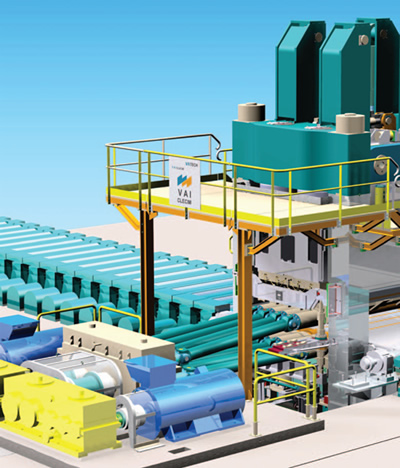 |
On the face of it, it’s been all change at UGS since the Siemens acquisition, such as a new name: UGS PLM Software. But alongside this shift, a few things have remained constant. One of those is its mid-range offering, Solid Edge.
Solid Edge has always been the poorer cousin to the likes of SolidWorks and Inventor in terms of marketing, awareness, and, to be brutally honest, sales. But technically, the system could challenge any of its competition and still win.
This awareness problem started to change two years ago with the launch of Velocity Series. Solid Edge plays a key role in the Velocity Series, which combines Solid Edge’s 3D product definition capabilities with mid-range PLM offering Teamcenter Xpress, Femap analysis software, and now NX CAM Xpress. But while the Velocity Series is about a range of modular, yet integrated tools and technologies, what we really want to get down to here, is what’s around the corner for Solid Edge V20. As with all Solid Edge releases, there are several key themes, and in V20 these themes are continued in Design Collaboration, Massive Assemblies capability, and Engineering Productivity.
Design Collaboration
A good place to start is 2D migration. All vendors are chasing the AutoCAD user community and will continue to do so for the foreseeable future — after all, there’s a lot of people out there still using 2D. For those who missed it, UGS PLM Software released a free 2D application last year and it’s been downloaded by more than 50,000 users. This brings all of the 2D drafting tools available in Solid Edge and reduces the cost to absolute zero, meaning that instead of maintaining AutoCAD licenses, you can switch, which is kind of the plan. But within those tools and within Solid Edge at large, you also have tools to assist with making use of AutoCAD data — and these have been updated.
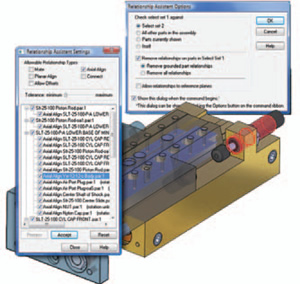 Solid Edge V20’s new Auto-Constrain tools let you add assembly mating conditions semiautomatically to build intelligence back into third-party files in a very short time frame. |
For example, the system now supports the ACAD Color 7 attribute, which automatically inverts black/white lines depending on background sheet color, so your drawings are displayed exactly as they were in AutoCAD. The Solid Edge translation tools now support multi-sheet drawings, Image and Smart Frame objects, images with drawings, blocks, embedded documents, and such from AutoCAD. The system has also been extended to support the loading of Xrefs from AutoCAD — meaning your DWG data loads and displays as it did in AutoCAD Design Collaboration.
Moving into 3D data exchange, Solid Edge now has an additional cost option for a CATIA V5 bidirectional translator that allows you to read and write .CatPart and .CatProduct files. It does not replace the existing CATIA V4 tools, and both translators can be purchased separately. Elsewhere you can read Pro/Engineer Wildfire 3 files and, should you want to, you can now load in STL files and use them as reference data.
Product Planning
Let’s look at the tools brought to this release for planning a new product. The last few releases have offered tools added to Solid Edge that make the planning of complex products less painful, allowing you to work at a very schematic, 2D sketch level, then flesh out the design as it progresses. This hasn’t changed, but what has changed or been extended now affords you much more control both over the product and how the data is managed.
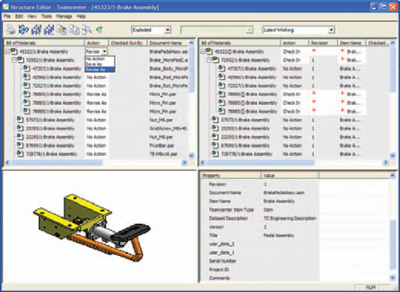 The new Structure Editor lets you reuse data from existing products by copying or referencing existing parts or subassemblies while using Teamcenter Xpress to manage the whole process. |
One thing that’s increasingly desirable in these days of dramatically reduced time to market is the ability to reuse portions of existing designs in a new project. So, with this in mind, the new Structure Editor lets you load an existing product Structure from Teamcenter Xpress and inspect, visualize that structure, run where-used searches and what not, with the eventual goal of reusing either all of it or just portions. It allows you to choose to replicate certain parts or subassemblies (so they remain the same), have them copied, and placed in the database as new items (so you can edit them). You have full control over the process, which is shown in a split-window format, with the source assembly on the left and the target on the right. Both views are synchronized so you expand subsystems or scroll, both views remain the same.
Another very useful new tool is the Assembly Auto-constrain capability. This lets you take an imported or legacy assembly, load it into Solid Edge, and use some intelligent tools to add assembly-mating conditions. It is fully automatic and lets you interact with the process to get the relationships you require much faster than doing such work manually.
Getting into the Zones
Now, let’s look at the tools available for working with really large assemblies. The first is Zones.
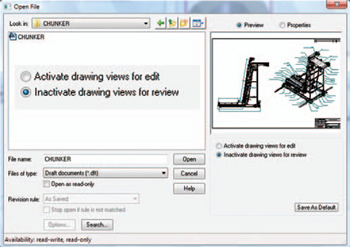 Drawing Review Mode disconnects your Drawing Sheets from the source 3D model, allowing you to load huge, complex drawing files instantly, add dimensions, print, and view. |
Zones are commonly used in higher-end packages by people in the shipbuilding, auto, and aero industries as a means to subdivide a product into more manageable parts. V20 brings Zones to the mainstream. Zones allow you to define spatial envelopes to isolate specific areas of a product. A Zone is intelligent and will update dynamically to include either parts that it entirely contains (Inside option) or that are within or intersect partially with that envelope (Overlapping option).
To create a Zone, you define it either by dragging out a box or by selecting parts you want within that Zone. When a Zone is stored within the assembly file, you can choose to open just a specific Zone, and the system will just load those parts into memory — the full product structure is still available in the PathFinder.
When you combine the Zone tool with the new intelligent caching (which will selectively unload parts from memory if you haven’t used or referenced them within a specific time frame), you have the potential to make working with large assemblies much more efficient.
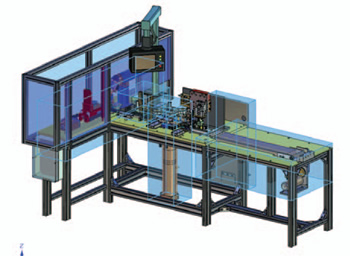 Solid Edge V20’s new Zoning tools enable high-end technology and working practices to filter down to the mainstream. Zoning allows an organization to subdivide a complex product into manageable chunks — Zones — using named intelligent zones. |
A new Drawing Review Mode essentially disconnects your drawing file from the source 3D assembly. This means you just load the drawing and nothing else, but can still actually work with it, as Solid Edge maintains links to the original data. All manner of 2D dimensions and annotations can be added, measurements taken, and jobs printed. As soon as you perform an action that requires 3D data (such as adding a new view or an isometric dimension), the system will just load the data you need — meaning that you take the performance hit only when you absolutely need to.
Productivity Enhancements
To be honest, we’re running out of space here and I know Lockwood doesn’t tolerate those reviewers that overstay their welcome, so I’m just going to conclude with a quick look-see at some of the other updates that didn’t quite fit into the first two categories.
The first is the impressive new Goal Seeking tools. Solid Edge has always allowed you to make the most of 2D working practices, either for sketching or planning more complex products. What this does is allow you to take a basic 2D sketch, create some parameters, then have the system vary a given input or variable to reach a desired design goal. You can only use one input and one output, but it adds a great deal of intelligence and can be integrated into the 3D modeling process very easily to add more intelligence.
Another update for this release is support for grouping both within the assembly and feature tree. You can create feature groups with a part model to assist with tidying things up — unlike other systems, these require that your groups do not break the feature construction history and will maintain it where possible. Within an assembly context, it allows you to create assemblies or subsystems from flat hierarchies, which will be useful for both existing assemblies that need a little organization, for product planning, and of course when working with complex imported assemblies.
A Rock-Solid Release
OK — there you have it, Solid Edge V20 highlights in a nutshell. It’s another rock solid release that combines two real things. The first is that the development has a real handle of what its users are doing, where they’re pushing the boundaries of what the product can handle — hence the Zoning, Structure Editor, and other assembly-handling tools. Structure Editor and Zoning are going to be highly useful for many, and it’s fantastic to see these types of technologies filtering down from the high-end systems into the mainstream where they are just as applicable. Elsewhere, UGS PLM Software seems to have realized that people work with third-party data and have provided some intelligent tools that allow you to bring this data in, work it into shape very quickly, and get on with the job at hand.
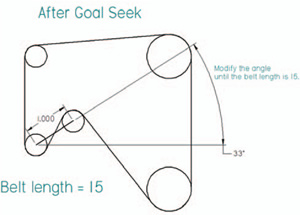 The Goal Seek functions lets you perform basic engineering calculations and optimization processes using 2D geometry linked with variables and a design goal. |
Secondly, there’s always the thought leadership. I love the introduction of the Goal Seek tools. Yes, Goal Seek is limited to just one input, but you can do something useful with it. I would hope this is expanded upon, as there is always a need to solve fundamental engineering problems at the very early stage. And when you consider that those tools are available in the free 2D application, that’s a powerful thing indeed.
To sum up; Solid Edge V20 is an impressive release, one that continues much of the good work accomplished in previous releases. While the Siemens acquisition is still at the very formative stage, it’s clear that Solid Edge is being developed aggressively. And with the advent of the Velocity Series, Solid Edge is starting to take the position it has deserved all along within the mainstream market.
Al Dean is technology editor at MCAD Magazine, a UK product development and manufacturing technology journal (mcadonline.com) and is editor of Prototype magazine (prototypemagazine.com). You can send comments about this article to [email protected].
Solid Edge V20
UGS PLM Software
Plano, TX
ugs.com
Subscribe to our FREE magazine, FREE email newsletters or both!
Latest News
About the Author
DE’s editors contribute news and new product announcements to Digital Engineering.
Press releases may be sent to them via [email protected].






